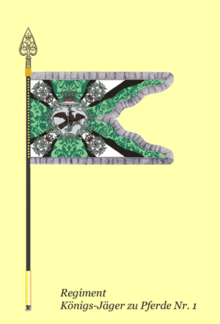King Jäger regiment on horseback No. 1
The regiment king-hunters on horseback no. 1 was a cavalry joined the Prussian army . The hunters on horseback were units of the light cavalry that were mainly used for reconnaissance and security tasks.
Organization and association membership 1914
- 10th division in Poznan
- 10th Cavalry Brigade in Poznan
- Commander: Major General Eduard Neven Du Mont
history
By the Highest Cabinet Order (AKO) of March 25, 1901, a "Combined Hunters Regiment on Horseback" was set up from October 1, 1901 (Foundation Day). Since the 2nd Body Hussar Regiment "Queen Victoria of Prussia" No. 2 , which had been stationed in Poznan , had been moved to Danzig , it seemed necessary to set up a new cavalry regiment in Poznan.
For this purpose, the five rider squadrons of the II., III., IV., V. and VI. Army corps in Poznan combined into one regiment and placed in the former barracks of the hussars. The first commander of the regiment was Major Gustav von Hollen of the Cuirassier Regiment No. 6 . For the formation of the regiment (or the previous reporting rider detachments ) the personnel, horses and equipment were pulled out of 17 dragoons , 14 hussars and 11 lancers regiments. The year 1905 was written until a new uniform was determined and the changing of clothes was completed (the previous dragoons, lancers and hussars had been wearing their original uniforms up until then, which was detrimental to the uniform appearance).
After the Reichstag approved the formation of three regiments of hunters on horseback in the same year, the regiment was added to the army list under the name of Jäger-Regiment zu Pferde Nr. 1 . On August 9, 1905, Kaiser Wilhelm II , King of Prussia in personal union, appointed himself head of the regiment , whereupon this was officially named Regiment Königs-Jäger on Horses No. 1 and the royal name with crown was affixed to the armpit flap and the cartridge .
First World War
At the beginning of the war, deployed directly to border security tasks in the east, the regiment transferred to the 5th Army on the western front in mid-August . From October 1914 to October 1916 the regiment was tasked with securing the rear area in the area of the 33rd Reserve Division on the Orne . Already in the spring of 1915 the 4th Squadron was detached from the regimental association and used as division cavalry in the 119th Infantry Division . In the autumn of 1916 the regimental association was temporarily dissolved and the individual squadrons also used as divisional cavalry in security tasks in the rear areas.
Whereabouts
After the war ended , the regiment returned to Poznan by Christmas 1918 and was demobilized in 1919 .
Until its dissolution, it retained its status as a cavalry regiment.
A train to the border guard in Upper Silesia was put together from volunteers .
The tradition was taken over in the Reichswehr by the training squadron of the 10th (Prussian) cavalry regiment in Züllichau .
Commanders
| Rank | Surname | vocation | Recall |
|---|---|---|---|
| Lieutenant colonel | Gustav von Hollen | April 1, 1905 | March 5, 1908 |
| Lieutenant colonel | Albert of Mutius | March 6, 1908 | March 21, 1910 |
| Lieutenant colonel | Viktor von Rosenberg-Lipinski | March 22, 1910 | June 29, 1914 |
| Major / Lieutenant Colonel | Otto zu Solms-Wildenfels | June 30, 1914 | September 17, 1918 |
| major | Strength of parents | September 18, 1918 | 1919 |
uniform
Pattern like cuirassiers, but with the following changes:
- Gray-green Koller (from 1910) tunic with Swedish lapels, lapels and all advances light green, shoulder flaps however advances in white as a badge color . To collar and cuffs light green braids that had a wide median strip and narrow margins in the badge color ran. For officers, the trimmings consisted of gold or silver braid with narrow stripes in the color of the badge.
- Field cap: Gray-green in color with light green stripes and white lugs
- Helmet: Similar to a cuirassier helmet, made of blackened sheet steel with a dragoon eagle. Edges with nickel silver edging rails. Tip like dragoon helmet with clover-leaf-shaped attachment. (Officers with fluted tips like cuirassier officers.) Arched scale chain made of tombac .
- Cuirassier boots made of natural brown leather
- Lance flag white-black
literature
- Hugo FW Schulz: The Prussian Cavalry Regiments 1913/1914. Weltbild Verlag 1992.
- Jürgen Kraus : The German army in the First World War. Uniforms and equipment. Militaria Publishing House, Vienna 2004.
Web links
Individual evidence
- ^ Günter Wegmann (Ed.), Günter Wegner: Formation history and staffing of the German armed forces 1815-1990. Part 1: Occupation of the German armies 1815–1939. Volume 3: The occupation of active regiments, battalions and departments from the foundation or formation until August 26, 1939. Cavalry, artillery, pioneers, motor and driving departments, armored forces, traffic forces and intelligence departments. Biblio Verlag, Osnabrück 1993, ISBN 3-7648-2413-1 , p. 191.

